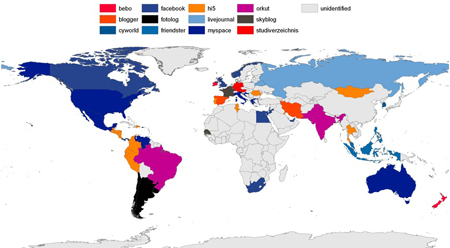I have IM accounts on AIM, iChat, Yahoo, MSN, Gmail and Skype. (Years ago, I once used ICQ and IRC.) I always find it interesting, how certain services are popular in specific countries. AIM is most popular in the US, where as, MSN more widely used in Asia, South American, Canada. IM, like all networks, benefit from network effects. If a service gains traction early in a country, when it can maintain growth, even if it is surpassed by other services who may be globally larger.
The shrunken image above from Valleywag shows which social networks are most dominant by market share, which was tipped off to me by hellowojo. The color coding is a bit confusing, because they decided to make match the countries by the color of the social network’s logo. Because most of social networks logos are blue, a network’s reach is difficult to differentiate. Fortunately, Valleywag also includes another graphic with a list of all the countries by social network.
Going forward these data will change. I wonder if there will be a consolidation of these networks, start into interconnect, or with they stay fractured, in the same way that email addresses were once closed. Here are a couple of possible of future scenarios.
Just as standards for email have been created, Open Social or some other social networking set of standards can allow for competing sites to share information with each other. WordPress or Moveable Type could become the open platform, where people host their own blog which would act like their profile, or use a service provider to maintain their profile/blog. Gigaom has postulated WordPress’ move into social networking. Third party widgets could be created to offer function, such as status updates, photo albums, walls, and gifting applications to mimic many of the features of Facebook, LinkedIn, MySpace and others SNS. This sounds like a lot more work for the end user, which would be fine for the people who want to have control and heavy lifting which that entails. For the Blogger and LiveJournals users of the world, adoption is only going to take place if setup is as easy as creating a Blogspot or Facebook account.
Where the first example envisions some combination of blogs and SNS, another example is email fully integrating with social networking profiles. Google has been able to effectively enter the IM space by introducing a closely integrated chat client into its Gmail service. By sidestep the application download step, millions of their email users instantly became IM users. Similarly, the Xobni Insight plugin for Outlook, connects information profiles on email contacts, giving Outlook an SNS feel. I haven’t used Outlook in a couple of years, but if I did, I would certainly be trying to get a copy of Insight, which is still in an invite-only beta.
The final possibility to consider is the consolidation of social networking sites into one main site, which may have an open API like Facebook, but is also closed and propritary in the sense that people cannot easily export their profile data out of Facebook, MySpace, or Orkut. While people can leave at any time, if all your friends and contacts use a network then there is incentive to stay in that network. In this way, a company like Google, Yahoo, and MSN could use its adjacent email or blogging services to leverage its entrance into social networking and possible become the de facto platform. Although, as of yet, none of these sites have been about to make a major impact across continents.
So, I guess we’ll just wait and see what happens.





I’m sure if you zoomed into Manhattan, there would be aubergine representing Manhunt.